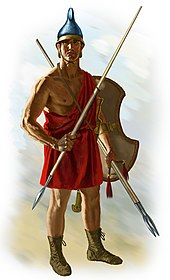Agrianes

The Agrianes (
Etymology and tribal belonging
Their name in
Geography
Their country was centered at Upper Strymon, in present-day westernmost Bulgaria, and also held areas of southeasternmost Serbia,[9] at the time situated north of the Dentheletae. In the times of Philip II, the territory of the Agrianes was administered by Pella.[10] According to some Bulgarian researchers they inhabited an ethnocultural region known today as "Graovo", whose name probably derives from that of the Agrianes.[11][12] Its location is in the central and eastern areas of modern-day Pernik Province.[13]
Military

The peltasts raised from the Agrianes were the elite light infantry of the Macedonian army. They were often used to cover the right flank of the army in battle, being posted to the right of the Companion cavalry, a position of considerable honour. They were almost invariably part of any force on detached duty, especially missions requiring speed of movement.[14]
Peltasts were armed with a number of javelins and a sword, carried a light shield but wore no armour, though they sometimes had helmets; they were adept at skirmishing and were often used to guard the flanks of more heavily equipped infantry. They usually adopted an open order when facing enemy heavy infantry. They could throw their javelins at will at the enemy and, unencumbered by armour or heavy shields, easily evade any counter-charges made by heavily equipped hoplites. They were, however, quite vulnerable to shock-capable cavalry and often operated to particular advantage on broken ground where cavalry was useless and heavy infantry found it difficult to maintain formation.[15][16]
History
They are first mentioned regarding Megabazus' campaign in 511 BC.[2] In 429 BC they were subject to the Odrysian kingdom[17] and later, as early as 352 BC, they became allies of Philip II of Macedonia.[18]
They fought under king
See also
References
- ^ "Agrianes: Greece (Paeonia)". Trismegistos. Retrieved 23 November 2016.
- ^ ISBN 9780786402281.
- ^ a b Merker, Irwin L. (1965). "THE ANCIENT KINGDOM OF PAIONIA". Institute for Balkan Studies (Greece). 6 (1): 36–37.
- ^ Strauch, Daniel (31 December 2020). "Agraii". Brill Publishers.
- ISBN 978-1-4443-3838-6, retrieved 2021-01-02,
...an Agrianos month is found throughout the Dorian and Aeolian worlds. (Burkert 1983: 168–79).
- ^ Pausanias, 5.1.5; Smith "Paeon" 3.
- ^ Wheeler, James Talboys (1854). The Geography of Herodotus ...: Illustrated from Modern Researches and Discoveries. p. 130.
- ^ The Cambridge Ancient History: pt. 1. The prehistory of the Balkans; and the Middle East and the Aegean world, tenth to eighth centuries B.C. Cambridge University Press, 1991. University of Minnesota/ The only writer who describes the Agrianes (under the form Agrii) as Thracians, is Theopom- pus (f 257(a)), but his evidence, isolated as it is, carries less weight.
- ISBN 9780230106406.
The Agrianians were a Thracian people from the area that is now southern Serbia
- ISBN 9780198148159.
- ^ Александър Фол, (1983) Историческа география на тракийските племена до III в. пр.н.е., Изд-во на Българската академия на науките, стр. 23.
- ISBN 9540736919.
- ISBN 9781443832632. Retrieved 23 November 2016.
- ^ Ashley, p. 45-46.
- ^ Connolly, pp. 48-49.
- ^ Sidnell, pp. 57-59
- ^ Herodotus; Macan, Reginald Walter (1908). Herodotus, the Seventh, Eighth, & Ninth Books: Pt. I. Introduction. Book VII. (text and commentaries).
- ISBN 9780892413300.
- ^ Darko Gavrovski, “TETOVO ANTIQUITIES - Polog valley from Prehistory to 7th century AD, with special emphasis on the Tetovo region”, Tetovo, 2009. English summary on: "Index". Archived from the original on 2009-08-04. Retrieved 2009-06-26.
- ISBN 9780192833402.
Bibliography
- Ashley, J.R. (2004) The Macedonian Empire: The Era of Warfare Under Philip II and Alexander the Great, 359-323 B.C. McFarland.
- Connolly, P. (1981) Greece and Rome at War. Macdonald Phoebus, London. ISBN 1-85367-303-X
- Sidnell, P. (2006) Warhorse: Cavalry in Ancient Warfare, Continuum, London.
- Viktorija Sokolovska, Pajonskoto Pleme Agrijani i vrskite so Damastion, Macedonia acta Archaeologica 11, Skopje 1990, 9-34. (with summary in French).
- Viktorija Sokolovska, The Coinage of Agrianes, MACEDONIAN NUMISMATIC JOURNAL no. 2, Skopje 1996, 13-22.
- Viktorija Sokolovska, Materijalna kultura Agrijana, Patrimonium Mk no. 16, Skopje 2018, 79-102.
